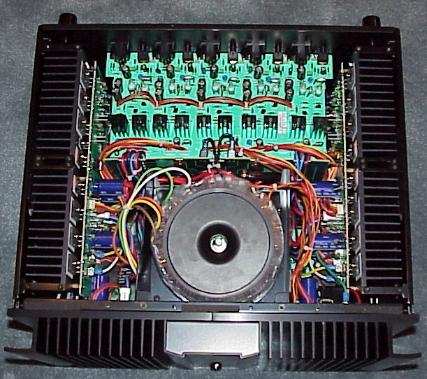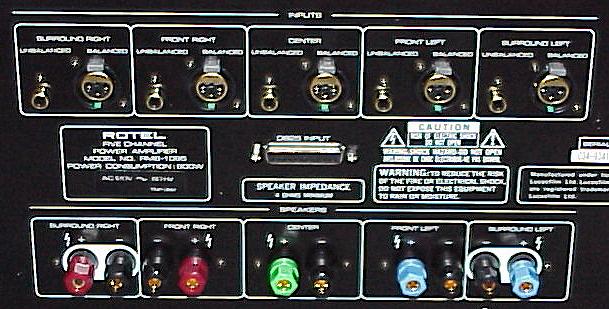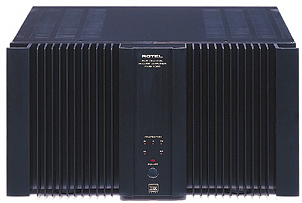Product Review - Rotel RMB-1095 Five-Channel Power Amplifier - January, 2000
|
Rotel RMB-1095 Five-Channel Power Amplifier 200 Watts/Channel rms into 8 Ohms, all Channels Driven, 20 Hz - 20 kHz THD: < 0.03% MFR: 15 Hz - 100 kHz +0.5 - 3 dB Size: 9" H x 17" W x 16" D Weight: 70 pounds MSRP: $1,999 USA |
| Rotel of America, 54 Concord Street, North Reading, Massachusetts 01864; Phone 978-664-3820; Fax 978-664-4109; Web http://www.rotel.com |
Introduction
Now that Dolby Digital and DTS sound in home theaters are the norm, everyone is building high power five-channel amplifiers. Rotel is no exception, and their new RMB-1095 is really something. When I lifted the review unit out of the shipping box, I knew I was in for an experience. It weighs 70 pounds, and most of that is a result of what's inside.
Nuts and bolts
The front of the 1095 has a broad expanse of heatsink fins with an on/off pushbutton and power-on/overheat indicator LEDs for each of the five channels. There are also two handles along the front sides that blend into the heatsink look, and it is obvious Rotel has put the heatsinks on the front for the aesthetics. It is very 2000 (are we one of the first to say this?) You might think, "Wow, that is a big heatsink." Well, take a look at the inside of the chassis.

The sides have heatsinks too, across their entire internal breadth. The output bipolar transistors, six for each channel, are distributed across the heatsinks. They are high output devices, made to handle 200 watts of power for all those action movies we love so much.
When I first looked into the chassis, I saw a huge toroidal transformer. Then, I noticed another one underneath. So, this hawg has two very large toroids that span the entire height of the amplifier. That is a lot of transformer. The power supply capacitors are under the green circuit board in the photo, while the output stages are across the sides and front. The top transformer is the larger, supplying three channels, while the smaller one (but it is still big) on the bottom supplies the remaining two channels.
The rear panel of the 1095 is nicely laid out with the inputs across the top and the outputs (color-coded) across the bottom. There is also a DB-25 input jack (seen in the center of the panel photo) for use with processors that have DB-25 output jacks (such as Rotel's processors). I wish more companies would incorporate DB-25 connectors. It would sure make things a lot easier.

Each amplifier channel has both an RCA
unbalanced input and an XLR balanced input. Both types of input are modular,
having been soldered to the rear of the power supply circuit board (the green
board in the photo). There continues to be confusion about the nature of
balanced inputs and the amplifier itself.  An
amplifier that has balanced inputs but is not balanced throughout the entire
internal circuit, is called "quasi-balanced," while an amplifier with
the balanced inputs and balanced throughout its internal circuitry is
"fully balanced," or perhaps called "differential".
An
amplifier that has balanced inputs but is not balanced throughout the entire
internal circuit, is called "quasi-balanced," while an amplifier with
the balanced inputs and balanced throughout its internal circuitry is
"fully balanced," or perhaps called "differential".
The 1095 is quasi-balanced. The photo on the right shows the pair of input jacks, and you can see that they are both little modules attached to the circuit board. The idea behind balanced circuits, including the inputs, is that common mode noise gathered by the connecting cables and wires in the amplifier will be cancelled out. XLR inputs on quasi-balanced amplifiers will work only for the interconnects, if they work at all. I say that because I have heard some quasi-balanced designs where the balanced input produced more noise than the unbalanced input. However, on the 1095, I was delighted to find that the balanced input really does a good job of reducing noise. I have some very long interconnects, and the unbalanced cable allowed lots of buzzing to come through, while the balanced cable resulted in a very quiet background. Also, I could not detect any difference in sound quality (other than the noise) when the signal was being passed through the XLR module, so it appears that Rotel has engineered the balanced input extremely well. Since the internal circuitry is not balanced, the consumer does not need to buy the expensive balanced interconnects to get great sound from the 1095, as long as there are no hum or buzzing problems induced from such things as lights on solid state brightness controls (a notorious culprit).
The sound
I tested the RMB-1095 with the full array of our reference items. Using it as a two-channel amplifier with our McCormack CD package and BAT VK5i triode preamp, I was surprised at how close it came to the BAT VK-500 power amplifier (250 watts per channel). The dynamics and deep bass were there. Of course, the BAT has subtle details in the background that only an amplifier of such extreme caliber can achieve, but the 1095 came close . . . say 95%. One might think that a five-channel amplifier does not need to have those sonic details since movie sound tracks are not that good. But, most of us now are thinking of ways we can incorporate our two-channel stereo CD listening and home theater all into one really nice system, so it is important to see how well the home theater product performs in this arena. I would classify the 1095 as high-performance, with the BAT as an ultra-performance product. The low priced mass market receivers could just stick with the name "mass market" (no one really wants to call them "low-fi"), while the mid-priced receivers could be called "mid-performance" or "mid-fi". The really expensive receivers are getting into true high-performance, but that is what one would expect from a product costing $2,000 - $3,500.
The 1095 performed well with all our speakers, including ribbons, which are notoriously difficult loads. The sound was smooth and never harsh, even at very loud volume. It has a slightly laid back high end, which is very appealing, since not only are many movie sound tracks relatively bright, but many CDs as well. Regardless of how sibilant voices are in the source, the 1095 handles them with ease. Also, I think Rotel has taken into account the probability that the consumer will listen at pretty loud volume, and a laid back high end characteristic makes high volume more tolerable. I like to turn things up once in a while myself, even though I have preached against it (boys will be boys), and the 1095 delivered everything I could possibly want with my collection of action DVDs (using a Yamaha DVD player and Yamaha DSP-A1 as the processor).

Frequency response tests showed the 1095 to be down 3 dB at 295 kHz with no load and down 3 dB at 245 kHz with a speaker load. On the low frequency side, It was down 3 dB at 6 Hz (from the measurement at 10 kHz). The 10 kHz square wave response is illustrated above.
Conclusion
Rotel has shown themselves to be a formidable competitor in the home theater market with such venerable products as the RB-985, even keeping the $1,000 price tag for that five-channel power amplifier when it was upgraded from 100 watts per channel to 110 watts per channel (the Mark II), and being THX certified as well (both models). However, the 1095 gets into the true high-performance category, notwithstanding the modest $2,000 cost. One might say that Rotel came into the high power amplifier arena a little late, so they have to keep the price lower to break into that category. Well, I think they just like to deliver a good value . . . period. The 1095 would have been $2,000 even if it were introduced a long time ago. Under any circumstances, the RMB-1095 is a killer product.
- J. E. Johnson, Jr. -
![]()
� Copyright 2000 Secrets of Home Theater & High
Fidelity
Return to Table of Contents for this Issue.


